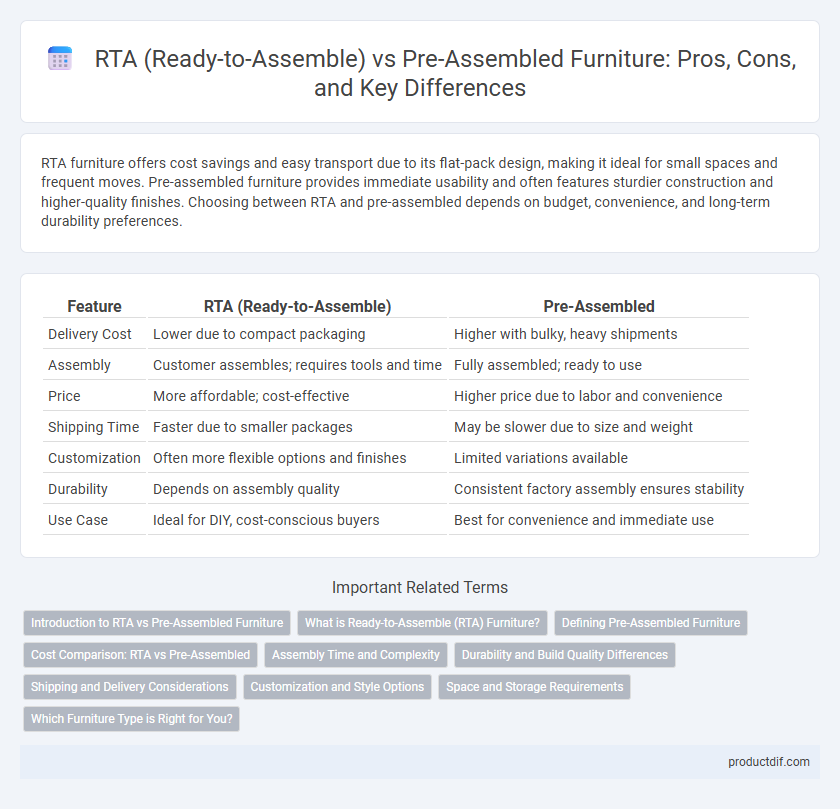RTA furniture offers cost savings and easy transport due to its flat-pack design, making it ideal for small spaces and frequent moves. Pre-assembled furniture provides immediate usability and often features sturdier construction and higher-quality finishes. Choosing between RTA and pre-assembled depends on budget, convenience, and long-term durability preferences.
Table of Comparison
| Feature | RTA (Ready-to-Assemble) | Pre-Assembled |
|---|---|---|
| Delivery Cost | Lower due to compact packaging | Higher with bulky, heavy shipments |
| Assembly | Customer assembles; requires tools and time | Fully assembled; ready to use |
| Price | More affordable; cost-effective | Higher price due to labor and convenience |
| Shipping Time | Faster due to smaller packages | May be slower due to size and weight |
| Customization | Often more flexible options and finishes | Limited variations available |
| Durability | Depends on assembly quality | Consistent factory assembly ensures stability |
| Use Case | Ideal for DIY, cost-conscious buyers | Best for convenience and immediate use |
Introduction to RTA vs Pre-Assembled Furniture
RTA (Ready-to-Assemble) furniture offers cost-effective solutions with easy transportation and customizable assembly, contrasting pre-assembled furniture that guarantees immediate usability and structural stability. The materials used in RTA furniture are engineered for flat-pack shipping, optimizing storage space and reducing shipping costs, while pre-assembled units often feature heavier, solid wood components for enhanced durability. Consumer preference hinges on balancing convenience, price, and long-term use between RTA's modular design benefits and pre-assembled furniture's ready-made robustness.
What is Ready-to-Assemble (RTA) Furniture?
Ready-to-Assemble (RTA) furniture consists of pre-manufactured components that consumers assemble at home, offering cost savings and easier transportation compared to pre-assembled furniture. Typically made from materials like particleboard, MDF, or plywood, RTA furniture includes all necessary hardware and instructions for assembly, catering to DIY enthusiasts. This type of furniture is popular for its versatility, space efficiency in shipping, and adaptability to modern lifestyles.
Defining Pre-Assembled Furniture
Pre-assembled furniture arrives fully constructed, eliminating the need for tools or assembly time, offering immediate usability. This type of furniture often features higher structural integrity and durability due to factory assembly standards. It is ideal for customers prioritizing convenience and time savings over shipping costs and packaging size.
Cost Comparison: RTA vs Pre-Assembled
RTA furniture typically costs 30-50% less than pre-assembled pieces due to savings in shipping and labor expenses. Pre-assembled furniture incurs higher manufacturing and transportation costs, which reflect in the retail price. Consumers opting for RTA benefit from budget-friendly options without compromising on style or durability.
Assembly Time and Complexity
Ready-to-assemble (RTA) furniture typically requires significantly more assembly time compared to pre-assembled pieces, with average setup ranging from 30 minutes to several hours depending on complexity. RTA products often involve multiple small parts and detailed instructions, increasing the risk of assembly errors without prior experience or tools. Pre-assembled furniture reduces complexity by arriving fully constructed, ideal for quick setup and minimizing effort, but often comes with higher shipping costs and limited packaging options.
Durability and Build Quality Differences
RTA (ready-to-assemble) furniture often features knockdown fittings and lightweight materials, which can impact its durability compared to pre-assembled furniture made with solid wood and robust joinery techniques. Pre-assembled furniture typically offers superior build quality, using higher-grade components and professional craftsmanship that enhance structural integrity and longevity. Consumers prioritizing long-term durability may prefer pre-assembled options due to their stronger construction and resistance to wear over time.
Shipping and Delivery Considerations
RTA (ready-to-assemble) furniture offers lower shipping costs and more compact packaging, making delivery faster and more efficient compared to pre-assembled furniture. Pre-assembled items often require larger shipping boxes and may incur higher freight fees due to their bulky size and weight. Choosing RTA furniture reduces the risk of damage during transit and provides greater flexibility in delivery options.
Customization and Style Options
RTA furniture offers extensive customization options, allowing consumers to select from various finishes, materials, and configurations to match their personal style and space requirements. Pre-assembled furniture typically provides limited style flexibility, as designs and finishes are fixed by the manufacturer. Opting for RTA enables tailored aesthetics and functional adjustments, enhancing the overall interior design experience.
Space and Storage Requirements
RTA (ready-to-assemble) furniture typically requires less storage space before assembly, making it ideal for smaller homes or limited storage areas compared to pre-assembled furniture, which demands ample space during delivery and installation. Once assembled, both types offer similar spatial footprints, but RTA units often include smart, compact design features that maximize storage efficiency. Choosing RTA furniture optimizes space management by reducing bulky packaging and allowing flexible assembly locations tailored to available room dimensions.
Which Furniture Type is Right for You?
RTA furniture offers cost-effective convenience and easy transportation, making it ideal for budget-conscious buyers or those with limited space. Pre-assembled furniture provides durability and immediate usability, perfect for individuals seeking high-quality pieces without the hassle of assembly. Choosing between RTA and pre-assembled depends on your priorities for price, time, and long-term investment in furniture quality.
RTA (ready-to-assemble) vs pre-assembled Infographic

 productdif.com
productdif.com